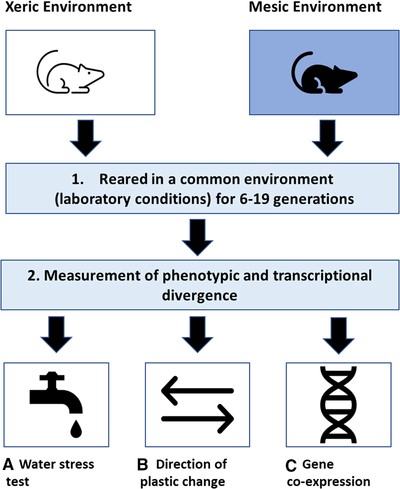-
PDF
- Split View
-
Views
-
Cite
Cite
Vikram P. Narayan, Digest: On the contribution of phenotypic plasticity to adaptation in desert environments, Evolution, Volume 75, Issue 6, 1 June 2021, Pages 1585–1586, https://doi.org/10.1111/evo.14267
Close - Share Icon Share
Abstract
How do organisms adapt to new environments, and what role does phenotypic plasticity play? Bittner et al. compared water consumption in laboratory-reared house mice derived from xeric and mesic populations and found evidence for adaptive phenotypic plasticity as well as genetic differences between populations.
Adaptation to novel environments occurs by modification of genetic variation via selection on particular phenotypes (Fox et al. 2019a). Phenotypic plasticity may facilitate or constrain this process. Acting at the level of an individual, phenotypic plasticity can enable rapid adaptation and survival in response to environmental changes (Chevin and Lande 2010; Chevin et al. 2010). However, plasticity can also impede adaptation by making genes invisible to natural selection (Ghalambor et al. 2007), and may even be maladaptive (Merila and Hendry 2014). While the importance of plasticity during the colonization of novel environments is now widely accepted, it remains unclear whether plasticity generally facilitates or impedes adaptation. Moreover, the contribution of phenotypic plasticity in desert adaptation remains an underexplored topic.
In this issue, Bittner et al. (2021) propose that responses to water stress in house mice (Mus musculus domesticus) are due to both genetic variation and plastic responses. To test their hypothesis, they provide an elegant framework using a common garden experimental design coupled with next-generation sequencing to determine the roles of plastic and evolved responses in adaptation to a new environment (Fig. 1). The authors first measured water consumption across lab-reared lines derived from wild populations in five locations in North and South America. The authors then chose lines from the populations that drank the most and the least water and tested the impact of water stress. Samples from these lines were then used for further morphological, phenotypic, and expression analyses.

Graphical representation of the methodology used by Bittner et al. (2020) to determine the contribution of phenotypic plasticity in adaptation to novel environments using mice from xeric and mesic environment raised under common laboratory conditions.
Bittner and colleagues found that under water stress, even after 6–19 generations, lab-reared descendants of mice from xeric environments drank less water and retained more weight after water stress than did descendants of mice from mesic environments. Both groups of mice were raised under identical laboratory conditions for multiple generations, indicating a genetic basis for these phenotypic differences between populations.
Blood chemistry showed that differences in osmoregulatory functions co-occurred with increased weight loss in descendants of mesic mice compared to their xeric counterparts. In addition, under conditions of water-stress, mesic mice generally displayed xeric-like shifts in kidney gene expression. Gene expression analysis showed both evolved and plastic responses in xeric and mesic mice. Taken together, these results suggest that while phenotypic plasticity was likely adaptive and aided in the colonization of xeric environments, genetic changes also occurred in house mice associated with strong selective pressures imposed by the desert environment.
Although there is a large body of work linking changes in gene expression to phenotypes of interest, many questions remain. In this issue, Bittner et al. (2021) used a framework to identify genes that may have been plastic in the ancestral colonizer population that were selected for and fixed in the current population. The authors did this by comparing genes that have a plastic response to water stress in the non-xeric population but are fixed in the hydrated treatments of both populations. Co-expression networks to identify groups of genes and specific hub genes might eventually help to identify mutations instrumental in adaptation to desert environments. It is also worth noting that while plasticity acts at the level of an individual, under environmental change the key to a population's survival is the viability and reproductive success of offspring (Fox et al. 2019b). Future studies on adaptive and non-adaptive plasticity in new environments may benefit greatly from also incorporating phenotypic measures of fitness such as reproductive success. The ultimate goal is to further understand the contributions of plasticity and genetic variation to the survival of a population in extreme environments.
LITERATURE CITED
Associate Editor: K. Moore
Handling Editor: T. Chapman
Author notes
This article corresponds to Bittner, N. K. J., K. L. Mack, and M. W. Nachman. 2021. Gene expression plasticity and desert adaptation in house mice. Evolution. https://doi.org/10.1111/evo.14172.



